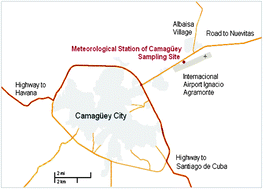Atmospheric aerosol particles were collected at Camagüey, Cuba, during the period from February 2008 to April 2009 in order to know the particulate matter levels (PM) together with a general chemical and absorption characterization. The aerosols collection was carried out with a low volume particulate impactor twice a week. Gravimetric analysis of the particulate matter fractions PM10 and PM1 was carried out. An analysis of the eight major inorganic species (Na+, K+, Ca2+, Mg2+, NH4+, Cl−, NO3− and SO42−) using ionic chromatography was conducted. The results were analyzed in two periods, the high aerosol concentration period (May to August) and the period with low aerosol concentration (the other months). During the high concentration period the average PM10 and PM1 levels were 35.11 μg m−3 (std = 15.45 μg m−3) and 16.86 μg m−3 (std = 6.14 μg m−3). During the low concentration period the average PM10 and PM1 levels were 23.13 μg m−3 (std = 5.00 μg m−3) and 13.00 μg m−3 (std = 4.02 μg m−3). For both periods, Cl−, Na+ and NO3− are the predominant species in the coarse fraction (PM1-10), and SO42−and NH4+ are the predominant species in the fine fraction (PM1). The spectral aerosol absorption coefficient, σa, was measured for the wavelength range 400–700 nm with 10 nm steps. The σa values were obtained with a filter transmission method for the fine fraction and were evaluated for 54 days covering a wide range of atmospheric conditions including a Saharan dust intrusion. σa ranges from 8.5 M m−1 to 34.5 M m−1 at a wavelength of 550 nm, with a mean value of 18.7 M m−1. The absorption Ångström parameter, αa, calculated for the pair of wavelengths (450/700 nm) presents a mean value of 0.33 (std = 0.19), which is a very low value comparing with those that can be found in the bibliography. Although the sampling period is short, these data represent the first evaluation of PM values with their chemical and optical absorption characterization in Cuba. In addition to the regional interest, the presented values can be directly used by those working with absorption, forcing by aerosols and radiative transfer calculations in general. Also, these data can be used as input in Global Climate Models.


 Please wait while we load your content...
Please wait while we load your content...